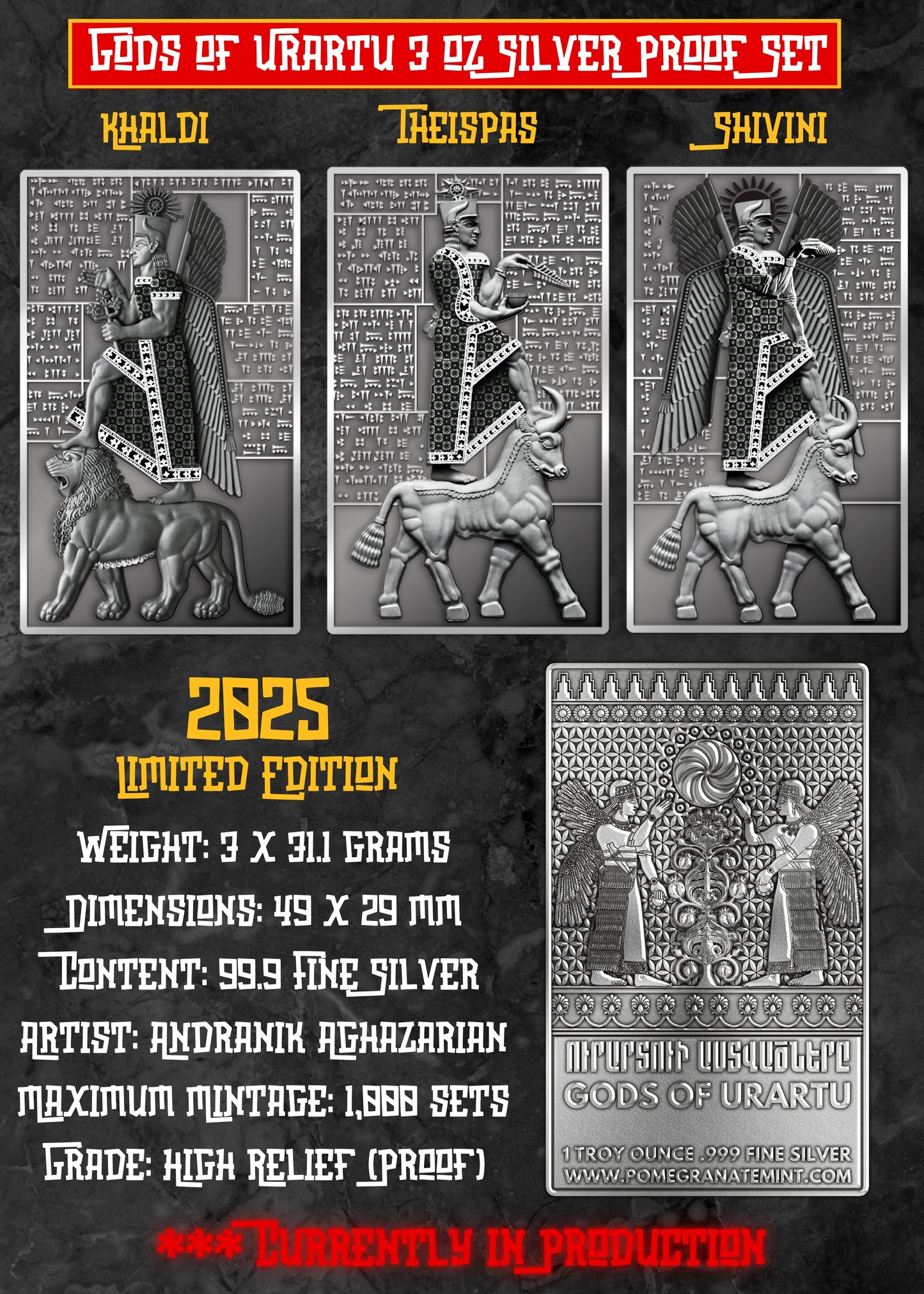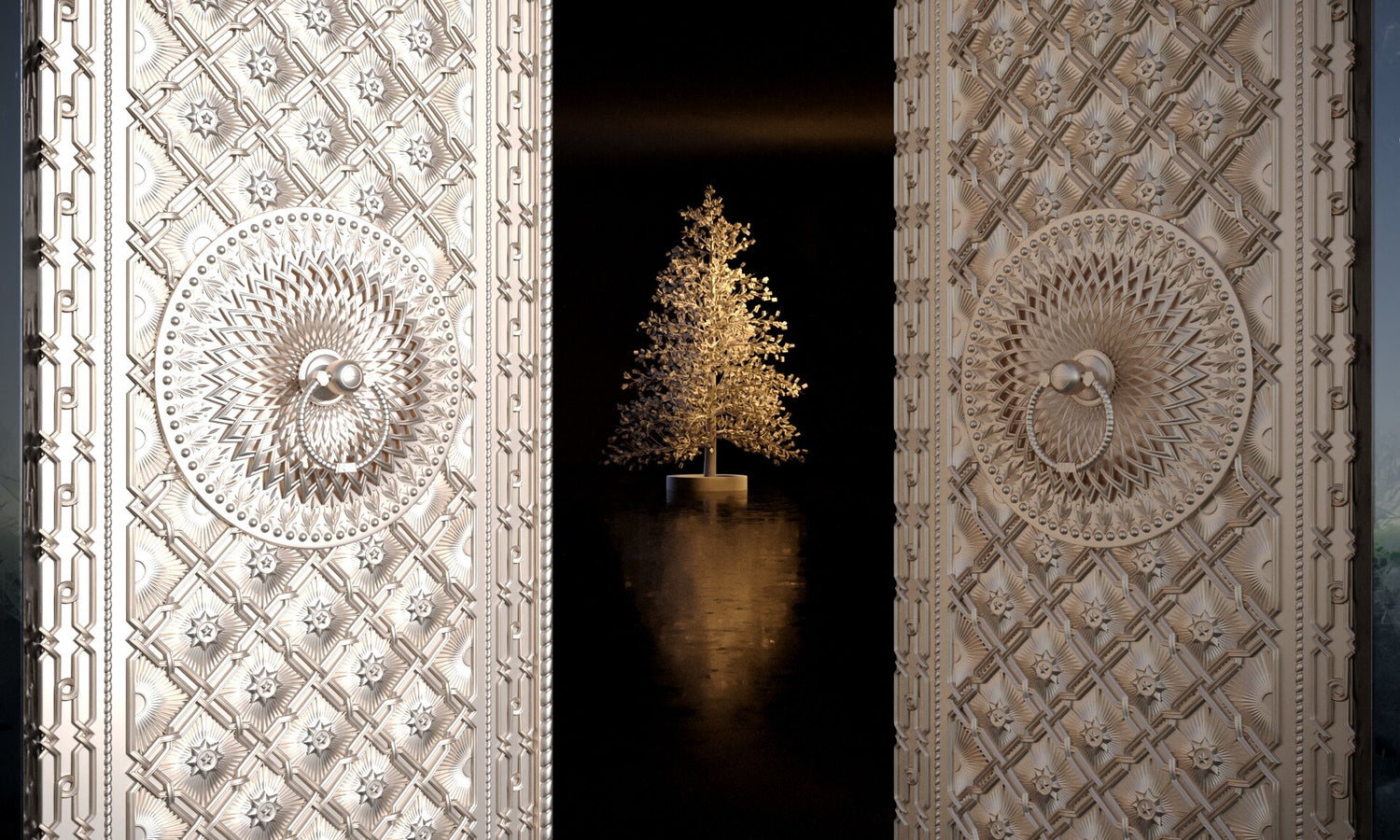Pomegranate Mint
PRE-ORDER 2025 Gods of Urartu 3 oz Silver Proof Set
PRE-ORDER 2025 Gods of Urartu 3 oz Silver Proof Set
Couldn't load pickup availability
*** This set of (3) 1oz bars is currently in production and will be released in mid 2025! You are able to pre-order your low serial number copy now!
Limited Edition Set, only 1000 sets will be produced!
Who were the Gods of Urartu?
Khaldi, God of War and Order
Khaldi or Haldi, the chief deity of Urartu, was the god of war and victory, embodying strength, leadership, and divine authority. He was revered as the protector of the Urartian kings and their armies, and his name became synonymous with the might of the Urartian state. Khaldi’s primary temple was located in Ardini, also known as Musasir, a sacred city that held immense spiritual significance for the Urartians. The temple housed a golden statue of Khaldi, adorned with precious metals and gems, reflecting his status as the supreme god. Kings would often invoke Khaldi’s blessings before embarking on military campaigns, dedicating their victories to him through inscriptions and rituals.
Khaldi was often depicted standing on a lion, holding a flaming spear, or radiating fire, all symbols of power and dominance. Inscriptions also suggest that Khaldi’s worship was closely tied to statecraft, with rulers presenting offerings to him as a sign of their devotion and legitimacy. While the Urartians performed many sacrifices, they did not perform human sacrifices. The latest research indicates Khaldi was an indigenous God of the Urartian tribes, who transformed his powers, depitctions and duties, as the culture transformed over time. After the fall of the Urartians, a clear transormation of Khaldi into the beloved Vahagn Vishapakagh, can be seen, especially in his birth.
Theispas God of Weather
Theispas, also known as Teisheba, was the Urartian god of storms, thunder, and weather, often associated with fertility and the life-giving power of rain. As the deity responsible for controlling the skies, Theispas was vital to the agricultural success of the Urartians, whose livelihoods depended on the cycles of rainfall and irrigation. His primary cult center was located in Kumenu, near modern-day Altıntepe, where elaborate rituals were performed to ensure favorable weather and abundant harvests.
Depictions of Theispas show him wielding a thunderbolt, holding a hammer, and/or standing atop a bull, an animal symbolizing strength and fertility. Bulls were often sacrificed in his honor to appease his temperamental nature and secure his blessings. Theispas had significant parallels with the Hurrian storm god Teshub and Hittite weather deities. Since the Urartian people were indecendent from, related to and in contact with these neighboring peoples of the Ararat Plain, this indicates a shared cultural and religious heritage among the ancient Near Eastern civilizations. The duality of Theispas as both a bringer of life and a force of destruction reflects the Urartians' understanding of the natural world as a balance between creation and chaos. Through shared contact, theses Storm Gods inpired the Greek Zeus & Nordic Thor.
Shivini, The Sun God
Shivini, the Urartian sun god, symbolized light, life, and divine justice. As the bringer of illumination, Shivini was closely tied to the cycles of day and night, representing the perpetual renewal of life. His chariot, said to be drawn by four fiery horses, raced across the heavens each day, casting light upon the Earth and dispelling darkness. The cult of Shivini was centered in Tushpa, modern-day Van, the capital of Urartu, where grand rituals were performed to honor his role in sustaining life and maintaining cosmic order. Shivini was also seen as a guardian of truth and morality, watching over humanity with his all-seeing gaze.
Shivini's characteristics align with solar deities from neighboring cultures, such as the Mesopotamian Shamash and the Hittite Arinna. These connections suggest a shared reverence for the sun as a universal life-giving force. Interestingly, inscriptions indicate that Shivini played a complementary role to Khaldi and Theispas, forming a divine triad that governed the heavens, Earth, and the forces of nature. Solar worship dates back to at least 8000 years in Armenia, with carvings found representing the sun. Sun worship would have taken place in Spring, when the sun returns to give life to the land, and bring light and all that is good for the people.

-
Free Shipping
If you spend at least $250 Canadian dollars with us, use coupon code FREESHIP, and we will cover the shipping.
-
Made for You
When you place your order, we will make your clothing orders especially for you.


